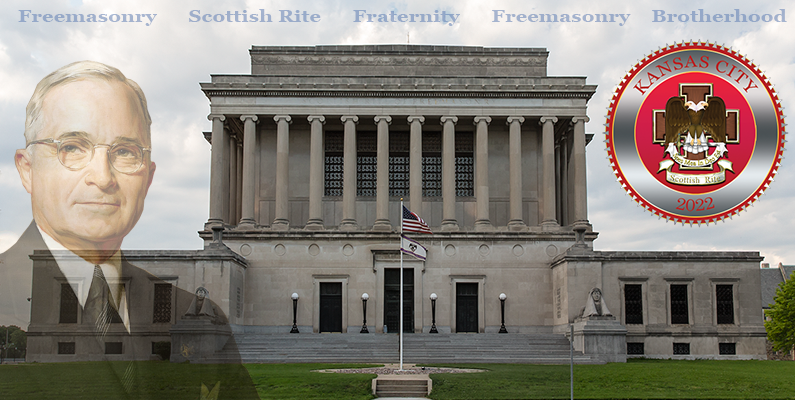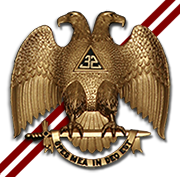
Scottish Rite History


Grand Commander Albert Pike, 33°
(Dec 29, 1809-Apr 2, 1891)
1850 - Raised, Western Star Lodge #1, Little Rock, Arkansas
1850 - Worshipful Master, Western Star Lodge #1, Little Rock, Arkansas
1853 - Worshipful Master ad vitam, Magnolia Lodge #60
1850 - Exalted in Union Chapter #2 RAM, Little Rock, Arkansas
1852 - Greeted as a Royal and Select Master, Washington DC
1853 - Created a Knight Templar, Washington D.C. Commandery #1 KT
1853-56 - Elected Grand High Priest, Grand Chapter in Arkansas
1853 - Received the 4th through the 32° - Scottish Rite SMJ
1857 - Coroneted 33° Honorary Inspector General
1858 - Crowned an Active Member, Supreme Council, SMJ U.S.A.
1859 - Elected M.P. Grand Commander, Supreme Council SMJ U.S.A.
Occupation: Grand Commander of the Supreme Council of the Southern Masonic Jurisdiction of the Scottish Rite, Attorney, Brigadier General - Confederate Army, newspaper editor, journalist.
Born in Boston, Massachusetts in 1809, his father died when Brother Pike was but a boy. He grew up in Newburyport, Massachusetts and was educated in private schools and an academy there. In 1825 he passed the required entrance exams and was admitted to Harvard University as a freshman. He taught school to pay for his tuition, teaching as well as attending to his own studies. On his return to Harvard for his junior year he passed his entrance exams but was advised that he must pay two-years tuition. Instead he taught himself, going through the junior and senior classes while teaching, first in Fairhaven, then in Newburyport grammar school, first as assistant then as principal. He taught in a private school there for two or three years until March 1831. He then ventured to St. Louis where he joined a party of pioneers and continued on, reaching Sante Fe in 1832. He joined a trapping party in Taos and traveled down the Pecos River to the Staked Plains where he and five of the party, experiencing starvation and an exhaustion of their finances, returned to Fort Smith, Arkansas in December 1832. Brother Pike there taught school near Van Buren and wrote articles for local papers, including a series of political articles under the name Casca for the Little Rock Advocate, which was partisan for the Whig Party. His articles gained much acclaim and he won the position of associate editor for the paper.
Brother Pike went to Little Rock in October 1833 and was engaged as assistant secretary of the council for the legislature for that legislative term. He made a great deal of friends and acquaintances as he also continued his work for the Little Rock Advocate. He began reading the law and was licensed to practice law by Thomas J. Lacy of the Territorial Superior Court in October 1834.
In his personal life, Brother Pike met and was stricken by a beautiful Mary Ann Hamilton. He pursued her and was married October 1834. One of the many poems he wrote to win her, "To Mary," survives to this day. They lived together in a home he built for them in Little Rock until after the end of the Civil War.
He purchased 'The Advocate' in the Spring of 1835 and entered into a partnership in a law practice with William Cummins which lasted for several years.
In 1836 he was engaged to supervise the Revised Statutes of Arkansas. He continued his study of the law, while continuing maintaining the operation of The Advocate, restricting his sleep to maintain his schedule. He rapidly developed his reputation as a lawyer, practicing in the state courts of Arkansas, in the district and circuit courts of the United States in Little Rock and was in 1849 admitted to the bar of the Supreme Court of the United States at the same time as Hannibal Hamlin and Abraham Lincoln. He practiced with distinction before the Supreme Court winning cases including some of which on behalf of the Choctaw, Creek and Cherokee Indians. In 1840 he was hired as the attorney for the Real Estate Bank becoming at trustee in 1842. He held both positions for twelve years.
In 1846 he raised a squadron of calvary and at the rank of captain fought with distinction in Mexico, his performance was complimented by two generals. It was during the Mexican conflict that he met General Robert E. Lee with whom he corresponded after the conflict.
Brother Pike noted in his auto biography that he was the first to propose a Southern Pacific Railroad. At Pike's urging the Arkansas legislature invited other southern states to attend a convention for the creation of such a railroad which Pike himself was unable to attend. Pike attended the second convention where he opposed the passage of a resolution in support of the slave trade. He declined to attend the third convention after the subject of the slave trade had been agitated and the resolution was likely to be offered again. In 1851 he was invited to address the legislature in Baton Rouge and won passage of a charter for a Pacific railroad with termini on the Pacific at San Francisco and Guaymas.
Brother Pike wrote in his biography that in 1851 or 1852 he decided to move his practice to Louisiana and began to study Louisiana law, the Pandects and refresh his knowledge of Latin and French after twenty years of disuse. He terminated his partnership in Little Rock and moved to New Orleans in 1853 where he formed a new partnership with Logan Hunton. He had read the Pandects, translating the first into English; the twenty-two books of Duranton, several volumes of Pothier and the five volumes of Marcade. After an interview and review he was granted a license to practice law in Louisiana and engaged himself there for three seasons. He suspended his practice in Louisiana to represent Indian cases in Washington D.C. then resumed his practice in New Orleans in 1857.
Also in 1859 he was awarded a large claim for the Choctaw Indians from the U.S. Senate from which he was to receive a large claim which he never realized but a small payment in 1861. In 1861 Arkansas severed it's ties with the United States. Brother Pike was appointed to the rank of Brigadier General in charge of the Indian Territory. Against General Pike's protests Indian regiments were ordered into Arkansas, engaging in skirmishes and one failed battle they named "Elk Horn." Serving as the Confederate Commissioner to the Indians General Pike made treaties of Amity and Alliance with the so-called civilized tribes and also with the Comanches, the Apaches, the Kiowas and the Kickapoos.
Brother Pike became disenchanted and resigned from the Confederate Army and served on the Arkansas Supreme Court for a time. At the conclusion of the Civil he War went to Canada. He then returned to Memphis were he practiced law and served as editor-in-chief of the Memphis Appeal and also as president of the bar association. In 1868 he moved to Washington DC where he was associate editor of the Democratic Newspaper, 'The Patriot' from 1868 to 1870. He lived in Washington DC and in Alexandria, Virginia until his death in 1891.
Fraternal History:
Brother Pike became an Odd Fellow sometime in the 1840s, gradually diminishing his activities in that fraternity after becoming a Mason in 1850. In 1850 Brother Pike began his rapid rise in Masonry when he was initiated in Western Star Lodge #1 at Little Rock and was raised to Worshipful Master of the Lodge in July of the same year. He then became a charter member of Magnolia Lodge #60 in Little Rock as it's first Worshipful Master in 1853. He held his membership there as Worshipful Master ad vitam until his death.
In the York Rite he was exalted in Union Chapter #2 RAM in Little Rock in 1850. In 1852, he was greeted as a Royal and Select Master in Washington DC. In 1853, he was created a Knight Templar in Washington Commandery #1 KT in Washington DC. He was elected Grand High Priest of the Grand Chapter in Arkansas in 1853, holding this office until 1856.
Brother Pike received the 4th through the 32nd degrees of the Ancient and Accepted Scottish Rite of Freemasonry on March 20, 1853. He was coroneted an Honorary Inspector General on April 25, 1857 and was crowned an active member of the Supreme Council, Southern Jurisdiction March 20, 1858 at Charleston, South Carolina. On the resignation of Brother John Henry Honour as Grand Commander on January 2, 1859, he was elected M.P. Grand Commander of the Southern Jurisdiction of the Supreme Council of the United States. Sovereign Grand Commander Honour expressed to Brother Pike that he expressly retired from his position to allow for the election of Brother Pike. Grand Commander Pike was also Honorary Member of the Supreme Council of the Northern Jurisdiction of the United States, England and Wales, Scotland, Ireland, France, Belgium, Italy, Greece, Hungary, Mexico, Brazil, Egypt, Tunis, Peru, Canada, Colon and Nueva Granada as well as Honorary Grand Master and Grand Commander of Brazil, Tunis and Egypt.
In 1859, Grand Commander Albert Pike, 33° published the Statutes, Regulations, Institutes, Laws and Grand Constitutions of the Ancient and Associated Scottish Rite in French and English.
The Albert Pike Statue was located at 3rd and D Streets, N.W. in downtown Washington, D.C. It is administered by the National Park Service and was placed in storage to assess damage during rioting in the capitol in 2020. Congress authorized the placement of the statue to Albert Pike on Federal land in Washington, D.C. on April 9, 1898, in Joint Resolution 20 (30 stat. 737). The Supreme Council of the Scottish Rite, Southern Jurisdiction, which Pike led for 32 years, sponsored and paid for the statue's erection, as recognition for his long service to the Scottish Rite. At the time of erection, the statue stood in front of the Scottish Rite House of the Temple. The enabling legislation did not refer to Pike's service in the Confederate Army, only of his Masonic service and was the only outdoor statue of a Confederate officer in Washington D.C. Pike was pardoned for his actions as a Confederate general by President Andrew Johnson after receiving petitions of Masons from all over the country.
Ref: Gen Albert Pike's Poems, Albert Pike's autobiography

